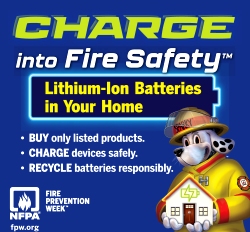|

“Charge into Fire Safety: Lithium–Ion Batteries in Your Home”
Technologies are evolving at an unprecedented pace and with new technology come new hazards and safety risks that need to be addressed. First introduced into the marketplace in 1991 by Sony Corporation, the implications of using lithium–ion batteries have become a significant public safety concern, primarily due to their propensity to overheat and undergo a dangerous phenomenon called thermal runaway. Once this process starts – due to overcharging, physical abuse, or extreme temperatures – the energy stored in the battery is released very suddenly, creating extremely high temperatures of up to 750 degrees Fahrenheit. In the end, this self–sustaining cycle of heat can result in fire or even explosion.
While commonly associated with cell phones and laptops, lithium–ion batteries have become the gold standard for rechargeable energy storage due to their lightweight design, high energy density, faster charging capabilities, and long lifespan. Despite their popularity, they are not without their disadvantages. To raise awareness about the potential dangers of lithium–ion batteries, the NFPA has chosen “Charge Into Fire Safety: Lithium–Ion Batteries in Your Home” as the theme for their 2025 Fire Prevention Week campaign. Using this year's fire prevention week as a platform, the NFPA aims to educate the American consumer about purchasing, charging, and disposing of lithium–ion batteries in order to ensure safe use and to minimize the environmental drawbacks. Learn more by visiting the NFPA Lithium–Ion Battery Safety page.
Fire Prevention Week commemorates what is known as The Great Chicago Fire that burned from Sunday, October 8, to early Tuesday, October 10, 1871. This notorious blaze was one of the largest U.S. disasters of the 19th century, killing 250 people, leaving another 100000 people homeless, destroying 17400 structures, and burning more than 2000 acres.
According to popular legend, about 9:00pm on Sunday, October 8, the fire began in a barn owned by Irish immigrants, Patrick and Catherine O′Leary. The couple had already retired for the night until their neighbors began calling out about the fire in the barn. A rumor, which was put into print by Michael Ahern, the Chicago Republican journalist, has it that Mrs. O′Leary′s cow kicked over a kerosene lantern that had been placed in the barn. However, some 22 years later, Mr. Ahern admitted that he had fabricated the “cow–and–lantern” story that had put the blame on Catherine O′Leary. Sure, there was a barn and a cow, but the official report could not determine the exact cause of the Great Chicago Fire on that fateful day. Despite rumors to the contrary, this legend took and is still widely circulated to this day.
This tragedy changed the way firefighters and the public thought about the importance of fire safety and fire prevention. On October 9, 1911, the 40th anniversary of the Great Chicago Fire, the Fire Marshals Association of North America (known today as the International Fire Marshals Association), sponsored the nation′s first Fire Prevention Day with the intent to raise awareness and to educate the public on fire safety. Nine years later, the day became an official national designation when President Woodrow Wilson issued the National Fire Prevention Day proclamation in 1920. To further commemorate this notorious event, President Calvin Coolidge proclaimed the first National Fire Prevention Week October 4–10, 1925 as a national observance to be honored every year on the Sunday through Saturday period in which October 9 falls.
|
